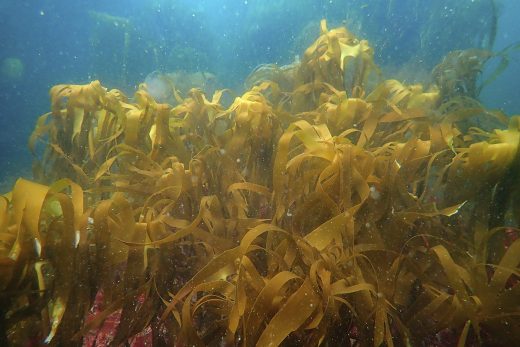The Surprising Consequences of a Seaweed Switcheroo
In the ocean off southwest England, cold-water kelp is being replaced by a warm-water species, with profound effects for the local ecosystem.
Article body copy
From Australia to the Arctic, kelp forests are disappearing as the ocean heats up. But in some places, such as in the chilly waters off England’s southwest coast, the struggling kelp ecosystem isn’t collapsing entirely. Instead, it’s being replaced. Over the past 80 years, once-abundant forests of the local cold-water kelp Laminaria hyperborea have slowly been overtaken by its warm-water cousin L. ochroleuca. Scientists aren’t sure yet how the newcomer is changing the ecosystem, but marine ecologist Daniel Smale is diving in to find out.
Smale grew up snorkeling these waters. He’s been observing the slow change of the kelp forests for nearly three decades—first as a teenager freediving to watch spider crabs, then as a scientist surveying the ecosystem. Certain spots once teeming with life now feel different, he says. Not devoid of life, but less bustling—a little less vibrant.
As the foundational species in kelp forests, kelp provides the structure and habitat that undergirds the ecosystem. The species of kelp affects what other organisms live there and how nutrients are used. Yet while much research has been conducted on what happens when a kelp forest disappears, little has been done on what happens when one kelp species is replaced by another. “These subtle shifts can go undetected or overlooked,” says Smale, who now works at the Marine Biological Association of the United Kingdom.
To discern how an ecosystem responds when a new kelp comes to town, Smale, in a new study, compared kelp forests at four sites around southwest England with two in Scotland, where the water is cooler and the warm-water kelp hasn’t yet crept in. The work shows that the replacement of L. hyperborea with L. ochroleuca can fundamentally change what organisms live in the ecosystem and cut the abundance of life in kelp forests.
The range of the cold-water kelp Laminaria hyperborea (first photo) historically extends from Portugal to the northern reaches of Norway. Laminaria ochroleuca (second photo), on the other hand, typically thrives in warmer southern waters in the Mediterranean and has only in recent decades crept up to Ireland and the United Kingdom. Photos courtesy of Daniel Smale
While his study focused on two kelp species and a few study sites, Smale says the general process—of a new kelp species encroaching on the historically dominant one—is likely playing out surreptitiously along many coastlines.
The sharp declines can be explained by the fact that L. hyperborea is an excellent host. A relatively unusual trait for kelp, it supports a robust growth of red algae on its brown rubbery surfaces. These red algae, in turn, support a thriving community of worms and gastropods, mollusks, and sea stars that feed fish and other hungry animals. In contrast, the warm water kelp L. ochroleuca had much less life growing on and around it.
In laboratory work examining kelp collected from their study sites, Smale and his colleagues showed how the replacement of one kelp with another leads to a huge difference in the biodiversity of the ecosystem. The cold-water kelp, they found, can support upward of 50 grams of red algae each. The warm-water kelp, in contrast, had almost none. This difference translated up the food chain. The cold-water kelp supported up to 375 invertebrates each, while a similarly sized warm-water kelp maxed out at 25.
This difference was clear in the field, too. The Scottish control sites, dominated by L. hyperborea, had about five times as many invertebrates as the English sites with L. ochroleuca. Because these invertebrates are food for fish and other species, the potential consequences are sweeping.
“The idea that changing from one species to another that’s relatively similar can have such profound effects is just fascinating,” says Jarrett Byrnes, a marine biologist at the University of Massachusetts Boston who was not involved in the research. “It’s a subtle shift that leads to profound changes that could amplify as you go up the food chain.”
Because kelp species swaps are far less studied than kelp forest loss, however, the full long-term impacts on everything from coastal fisheries to carbon sequestration remain unknown.
“It opens up a wealth of research that needs to be done as we watch our planet change,” says Byrnes.



